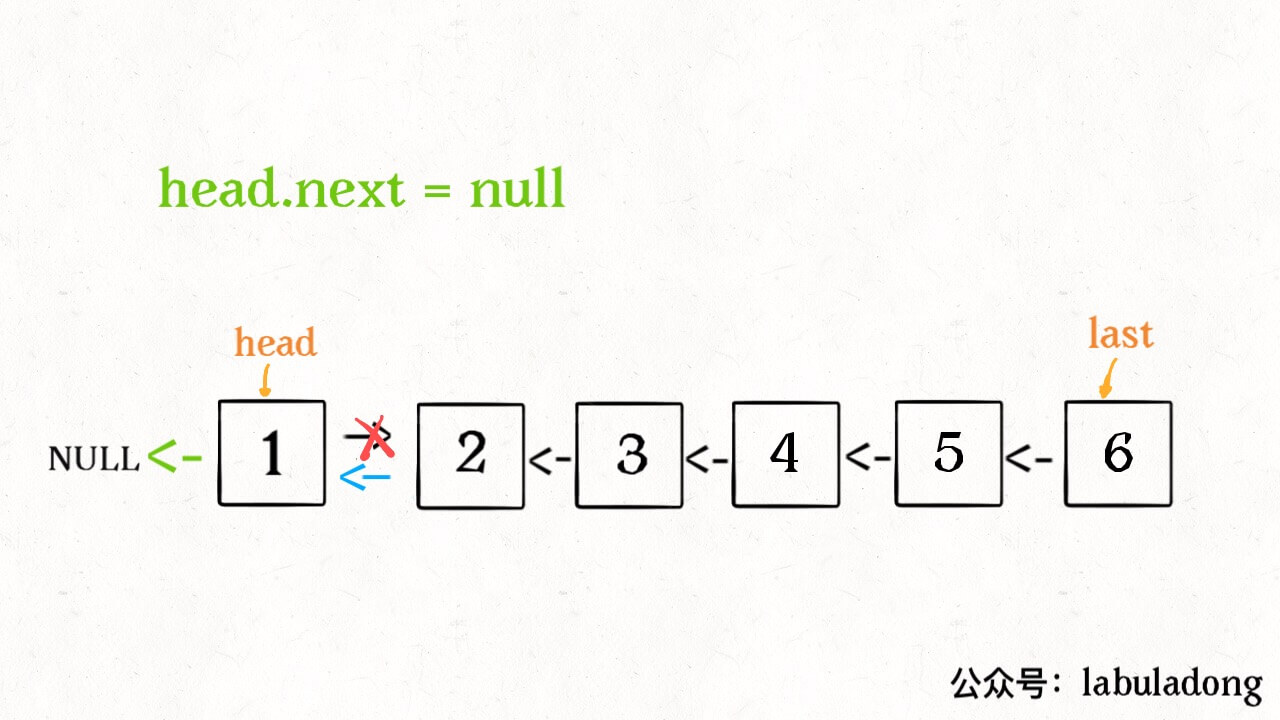问题:
206.链表反转。
Example: Input: 1->2->3->4->5->NULL Output: 5->4->3->2->1->NULL
92.指定区间链表反转。
Note: 1 ≤ m ≤ n ≤ length of list. Example: Input: 1->2->3->4->5->NULL, m = 2, n = 4 Output: 1->4->3->2->5->NULL
解法:Recursion(递归)
206.
1.递归获得2~6,反转后的结果。

2.将2->next指针,指向1:
由于原来1->next=2,因此 (1->next)->next = 1

3.将1->next指向NULL

BASE:
只有一个节点 or 0个节点,return head
代码参考:
1 /** 2 * Definition for singly-linked list. 3 * struct ListNode { 4 * int val; 5 * ListNode *next; 6 * ListNode() : val(0), next(nullptr) {} 7 * ListNode(int x) : val(x), next(nullptr) {} 8 * ListNode(int x, ListNode *next) : val(x), next(next) {} 9 * }; 10 */ 11 class Solution { 12 public: 13 //1->reverseList(2<-3<-4<-5) 14 ListNode* reverseList(ListNode* head) { 15 //base 16 if(!head || !head->next) return head; 17 //recursion 18 ListNode* newhead = reverseList(head->next); 19 //OPT 20 head->next->next = head; 21 head->next = nullptr; 22 return newhead; 23 } 24 };
92.
先解决,如何反转前n个节点。
reverseN(ListNode* head, int n)
相较于206,多了第n个节点之后的,不需要反转的节点successor
因此,比206多出的处理:
- ★BASE:
- 记录successor节点,n==1的时候,只剩一个节点
- successor = head->next
- recursion后的 ★OPT:
- head->next=successor
即,代码为:
1 ListNode* reverseN(ListNode* head, int n) { 2 //base 3 if(n==1) { 4 successor = head->next;//★BASE 5 return head; 6 } 7 //recursion 8 ListNode* newhead = reverseN(head->next, n-1); 9 //OPT 10 head->next->next = head; 11 head->next = successor;//★OPT 12 return newhead; 13 }
接下来,解决 从第m个开始,
递归到m==1,则变成上面的问题,直接调用reverseN即可。
其他情况,依次递归,不用更改任何指针。
⚠️ 注意:从第0个移动到第m个时的递归中,
返回值:当前的新头。所以,head->next=上次递归的结果。
代码为:
1 ListNode* reverseBetween(ListNode* head, int m, int n) { 2 if(!head || !head->next) return head; 3 if(m==1) return reverseN(head, n); 4 head->next = reverseBetween(head->next, m-1, n-1); 5 return head; 6 }
代码参考:
1 /** 2 * Definition for singly-linked list. 3 * struct ListNode { 4 * int val; 5 * ListNode *next; 6 * ListNode() : val(0), next(nullptr) {} 7 * ListNode(int x) : val(x), next(nullptr) {} 8 * ListNode(int x, ListNode *next) : val(x), next(next) {} 9 * }; 10 */ 11 class Solution { 12 public: 13 ListNode* successor; 14 ListNode* reverseBetween(ListNode* head, int m, int n) { 15 if(!head || !head->next) return head; 16 if(m==1) return reverseN(head, n); 17 head->next = reverseBetween(head->next, m-1, n-1); 18 return head; 19 } 20 ListNode* reverseN(ListNode* head, int n) { 21 //base 22 if(n==1) { 23 successor = head->next; 24 return head; 25 } 26 //recursion 27 ListNode* newhead = reverseN(head->next, n-1); 28 //OPT 29 head->next->next = head; 30 head->next = successor; 31 return newhead; 32 } 33 };